About Naples, Italy
Naples, a city in southern Italy, sits on the Bay of Naples. Nearby is Mount Vesuvius, the still-active volcano that destroyed nearby Roman town Pompeii. Dating to the 2nd millennium B.C., Naples has centuries of important art and architecture. The city’s cathedral, the Duomo di San Gennaro, is filled with frescoes. Other major landmarks include the lavish Royal Palace and Castel Nuovo, a 13th-century castle.
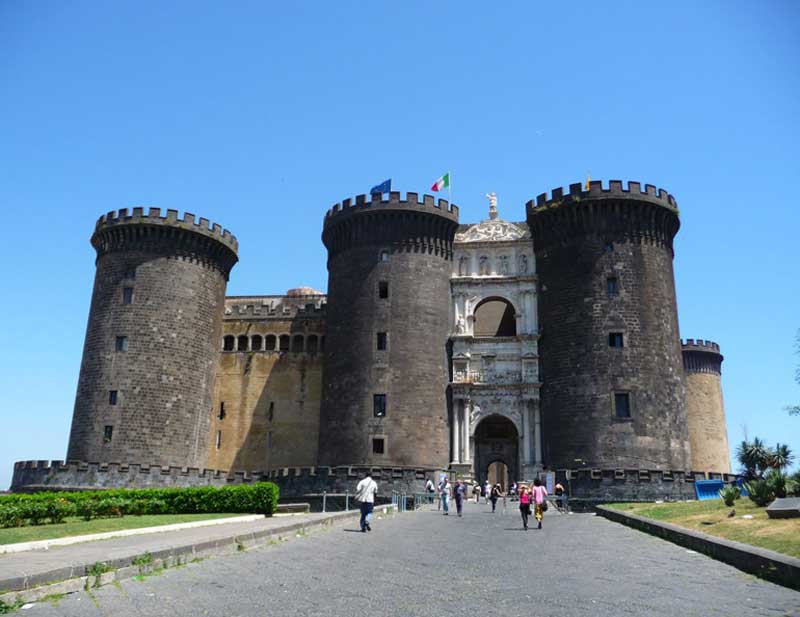
Plan and Book:



Overview
Naples can be an acquired taste. Italy’s third largest city is sure to conjure up strong feelings. For some it’s an admiration of the city’s authentic vibe, while for others it’s a dislike for the economic disparity that exists here. Sophia Loren and Enrico Caruso are native Neapolitans, and the city is stubbornly proud of its image. One thing is certain; you will not leave Naples without an opinion. Since late 1993, the city has sought to overcome its high crime rate by opening more museums and galleries, thereby attracting a cultured group of visitors and residents.
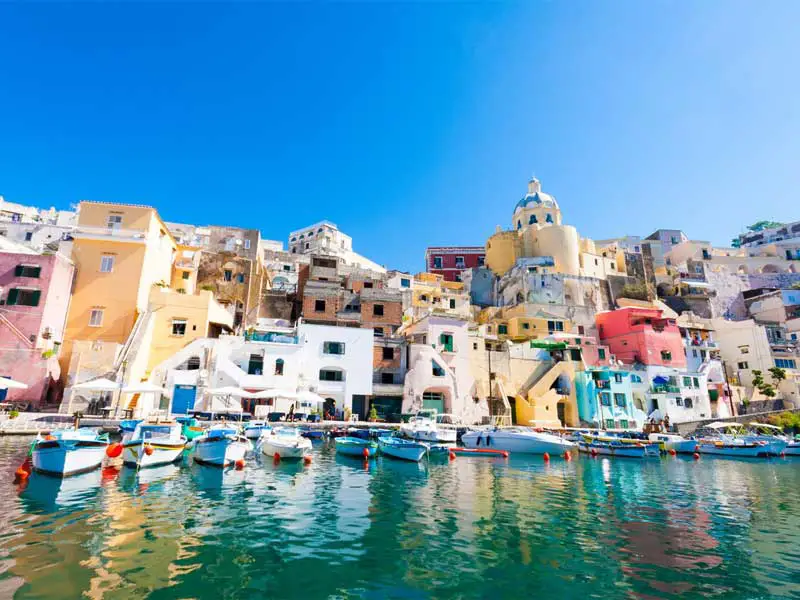
The unconventional strategy is starting to pay off, as crime is down twenty-five percent. The resulting feeling of security has increased tourism by almost fifty percent. Naples feels like any other big city in the world, with no need to fear for your safety. If Italy is the place to go for the best pizza and pasta in the world, and Naples is the best place to enjoy them in Italy, that would make Naples the pizza and pasta capital of the world, right? So bring your appetite! If you have the time, try and take a side trip out to Pompeii, the ancient city buried by a volcanic eruption on nearby Mount Vesuvius in 79 AD. The opportunity to see a city frozen in time is rare, and well worth a visit.
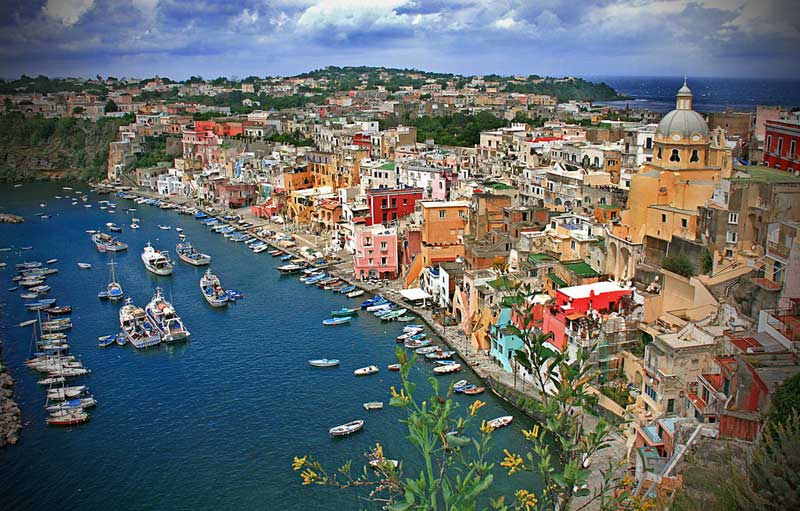
Recommended Tours
Hop-On, Hop-Off Tour of Naples: With three sightseeing bus routes, you’re never far from Naples’ museums, art galleries, restaurants, and chic shops.
Full-Day Tour of Capri: The island of Capri is a sparkling jewel set amid the neon-blue crown of the Mediterranean Sea. Spend a day on the island and explore its unblemished coastline, Roman ruins, colourful gardens, and designer shops.
Full-Day Tour of Pompeii and Mount Vesuvius: Explore two of Italy’s most celebrated sights: the ancient city of Pompeii (a World Heritage Site) and the volcano that unleashed its fury on the city, Mount Vesuvius.
Full-Day Tour of the Amalfi Coast: The ‘Amalfi drive’, zigzagging over hair-pin bends, is said to be Europe’s most spectacular stretch of coastline. Enjoy the views before visiting the towns of Amalfi and Ravello.
Half-Day Tour of Pompeii, a World Heritage Site: Buried by the eruption of Mount Vesuvius in 79AD, Pompeii stands frozen in time. Step back in time as you tread chariot-worn streets; marvel at exquisitely preserved villas and admire beautiful frescoes that still adorn ancient walls. As you stroll and explore, your guide will evoke life into the city.
Surrounding Area

Pompeii
Pompeii, in Campania, Italy, is not far from Naples. Its major attraction is the ruined ancient Roman city of the same name, which was engulfed by Mt. Vesuvius in AD 79. This is a UNESCO World Heritage Site. Romans took control of Pompeii around 200 BC. On August 24, 79 AD, Vesuvius erupted, burying the nearby town of Pompeii in ash and pumice, killing around 3,000 people, the rest of the population of 20,000 people having already fled, and preserving the city in its state from that fateful day. Pompeii is an excavation site and outdoor museum of the ancient Roman settlement. This site is considered to be one of the few sites where an ancient city has been preserved in detail – everything from jars and tables, to paintings and people were frozen in time, yielding, together with neighbouring Herculaneum which suffered the same fate, an unprecedented opportunity to see how the people lived two thousand years ago.
The cheapest way to get here from Rome – take the special (2 hrs 21 mins) train from Termini or the regular (1hr 10 mins) train to Naples. On the Circumvesuviana Napoli-Sorrento line it takes 30 to 40 minutes to get to Pompeii from either Naples or Sorrento. If in Naples Central Station get to Circumvesuviana section by following signs, the Naples-Sorrento train arrives at platform No.3. From Salerno you can take the local train service to Pompeii.
More

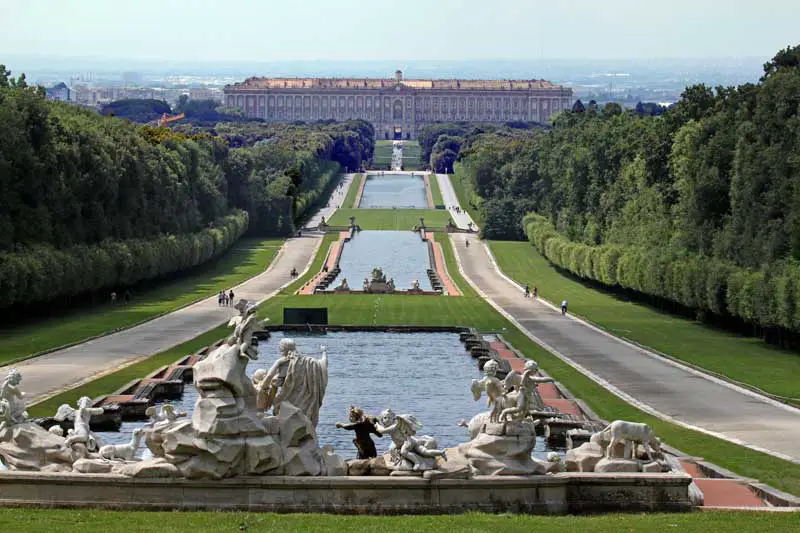
Caserta
Caserta is a city in Campania, 40 minutes north of Naples by train. Its main attraction is the Palazzo Reale (Royal Palace). During italian summer holidays it can get quite packed. During the rest of the year it is a sleepy town. Caserta Royal Palace (Reggia di Caserta) is arguably the most beautiful royal palace in Europe. Sometimes it is compared to Versaille, mainly due to the park architecture. It is a huge 18th-century palace and hunting lodge designed for the Bourbon Kings of Naples by late-Baroque architect, Luigi Vanvitelli. The palace is surrounded by a magnificent, enormous park with lakes, rivers, statues, fountains and marvellous views. In the park there’s a bus that takes you up and down the to the English Garden. Open all year except holidays. Last entry at 15:30 in the winter months. Caserta Royal Palace is just north of the Caserta train station.
Read More

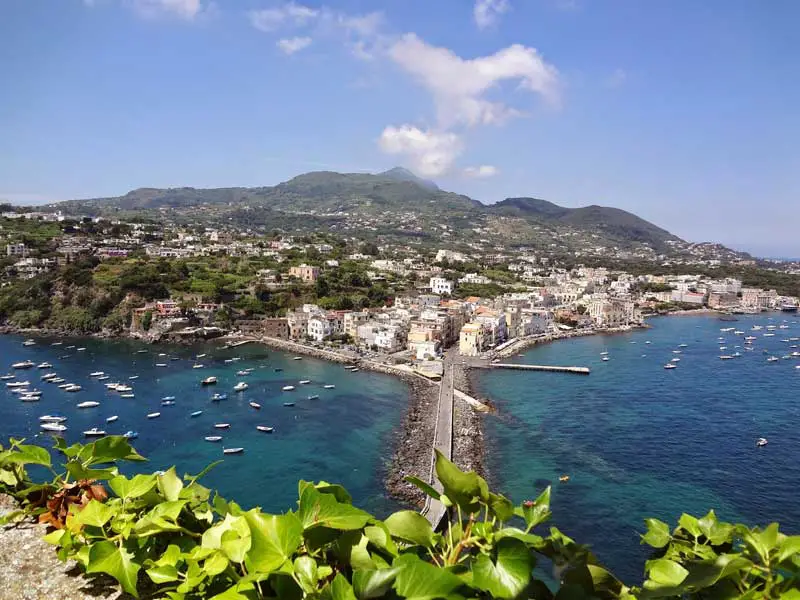
Ischia
Ischia is the largest island in the bay of Naples and is considered by many to be the most beautiful, (though Capri is considerably more famous). The island is 10 km from east to west and 7 km north to south. It has a coastline of 34 km and covers an area of 46.3 sq km. It has a permanent population of approximately 58,000. Up to 6 million tourists (principally from the Italian mainland and Germany) flock to the island for its volcanic thermal spas and as well for its beaches and food. Several towns are located along the island’s coast. The largest city in Ischia is actually (and often confusingly, for tourists) called Ischia. The town of Ischia, however, has two different centres: Ischia Porto and Ischia Ponte. Ischia Porto is the commercial center of the island and is named after the main port. Capri is reached in about 40 minutes by hydrofoil from Ischia.
Ischia’s thermal springs have been renowned since ancient times and have been tested by many Italian and foreign scientists, for their therapeutic features. Not only are the thermal waters used in baths and thermal gardens, but they can found in small springs on some beaches and streams of spouting that feature hot water gushing into the sea as well as steam spouts (fumaroles) with gases gushing from cracks in the soil. Fumaroles can also be observed on the slopes of the Mount Epomeo, particularly on cold days, or are located into small caves, called “stoves”.
Read More

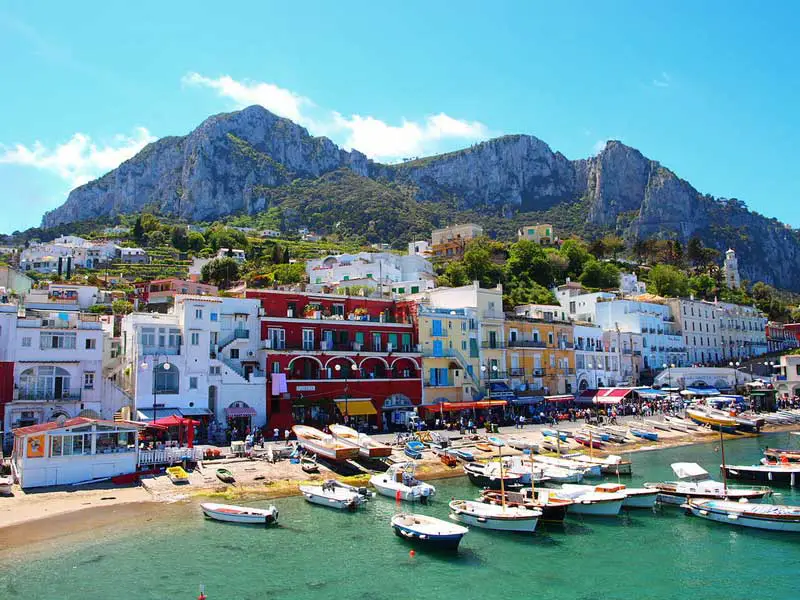
Capri
The small Italian island of Capri is situated 5 km from the mainland in the Bay of Naples, a celebrated beauty spot and coastal resort since the days of the Roman Republic until now. It is also part of Campania. Capri, known in Greek mythology as the isle of the sirens, was a favored resort of the Roman emperors. Most notoriously, the emperor Tiberius had his villa on the island, the location (supposedly) of debauched orgies. Those who displeased the emperor were flung to their deaths from the cliffs. The island is world famous and is very touristy, especially when swamped with tourists in July and August, but other times of year it is calmer and more relaxing.
The most famous natural attraction on Capri is the Blue Grotto, a beautiful cave at the water’s edge with a tiny opening to the sea that opens and closes with the tide, used as a bath since the Roman times. The entrance is small and depending on the tide there is just enough space for only a small rowboat to get through. Dark at the entrance, one has to enter 20-30 yards and then turn around to view the beautiful sight of the light from the entrance flowing through the water lit turquoise from below by the sun. Hence the sight of the “Blue Grotto”. You’ll be amazed at the turquoise hues glimmering in the water and against the rocks.
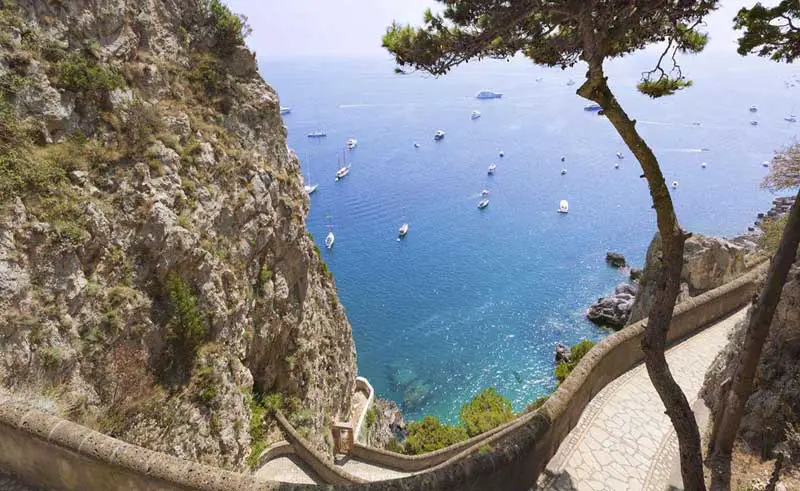
There are numerous ways to get around the island. You can see quite a bit of Capri on foot. From the main harbour to the town up the hill leads a range of stairs. Stairs and walkways, mostly signposted, crisscross the island. You can buy a map for a small fee at the main tourist office in the harbor which shows most of the footpaths. However, it is difficult to get lost on such a small island. A funicolare mountain tram (same as in Naples, Heidelberg, Barcelona and San Francisco) connects the harbour with the town up the hill. Island buses are readily available to take you to the various areas of the island. Unified public transport tickets are available. But one of the most fun things you can do here is rent a motor scooter and explore on your own historic Capri.
Capri is reached in about 40 minutes by hydrofoil from the port of Ischia or Forio, docking at Marina Grande on the north side of the island. There are also daily ferries from Naples (40 minutes), Amalfi, Positano and from Sorrento (20 minutes). Capri Online offers information on schedule and prices for all ferry/hydrofoil to Capri. If you take the early ferry from Naples (the one at 6.45AM), then as you travel to Capri, the sun rises over the mountains. The sky turns from deep violet to pink to orange to gold. It is an amazingly beautiful sight, certainly worth waking up at the ungodly hour.
Capri Online

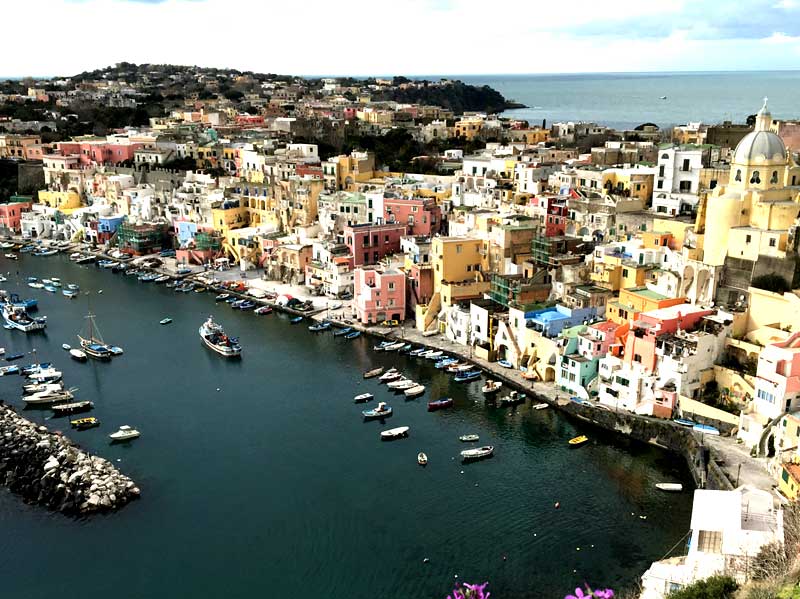
Procida
Procida is the smallest island of the Gulf of Naples; it is rich in attractions and archaeology. As well, the small island of Vivara, linked to Procida by a bridge, has archaeological excavations. The architecture of Procida has a Greek origin. In fact, the history of Procida is concentrated first of all on the medieval village Terra Murata and on Corricella, the fishing settlement. The landmarks of Procida reflect typical Mediterranean pastel colours. Procida has 6 beaches and 3 tufaceous sides with crystal-clear waters. Ferry services is available at reasonable prices from Naples, Capri, and Ischia. You can get ferry information via. You can take the metro to station Pozzuoli from the ground floor of Napoli Centro train station, then get off and take the ferry at the port of Pozzuoli.
Ferry and tourist information

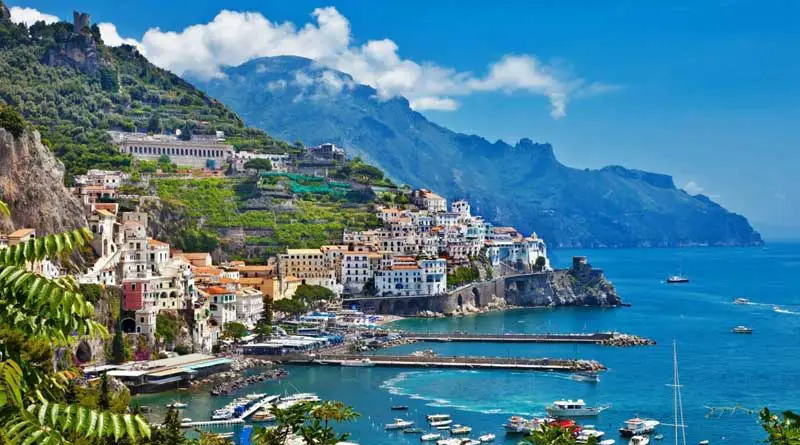
Sorrento
Sorrento is a popular tourist destination overlooking the Bay of Naples in Southern Italy. Perched atop cliffs that separate the town from its busy marinas, it is known for sweeping water views and Piazza Tasso, a cafe-lined square. The historic centre is a warren of narrow alleys that’s home to the Chiesa di San Francesco, a 14th-century church with a tranquil cloister. The town features beautiful architecture, many cafes and restaurants, and shops catering to tourists. As it is on the Circumvesuviana rail system it is easily reached from Naples and an ideal base for visiting Pompeii and Ercolano. Ferries regularly commute between Sorrento and Capri, making Sorrento an ideal base for exploring that island as well. A trip to Sorrento is full of possibilities, enjoy a splash in the Naples Bay, a walk through the lively pedestrian only streets at night, or an enjoyable day exploring the ruins of Pompeii. A short trip to Naples will take you to the National Museum that houses some of the best frescoes and art work from Pompeii. You can catch a bus that takes you on a spectacular but hair raising drive through the Amalfi Coast. You will pass through villages built along the cliffs that have some of the most beautiful churches and architecture in the area.
Sorrento is famous for its beaches – Marina Grande and (the better option) Marina Piccola are in the main beach area immediately to the west of the ferry and boat harbour). At Marina Piccola, some reserved areas with sand will ask for an entrance fee (which will also get you a deck chair) and for an umbrella. There is also a public beach at Marina Piccolo which has quite a small area of sand but ultimately you will be swimming in the same water as the private beach-goers. There is also a public sunbaking area consisting of a large wooden deck. Marina Grande, home of the fishing fleet, is a 10-15 minute walk west (via the city streets – no direct access via the coastline) and is quieter and has a larger public beach area with a few relaxed beach cafes and restaurants. A more spectacular option might even be Bagni Regina Giovanna, a nice little cove from the ocean in a secluded spot. Though a bit far on foot, it’s worth the trip (ask the locals for direction). Another option is Meta which has a larger beach again but requires a ride on the circumvesuviana train.
If you’re not in a hurry you can stroll from one end of town to the other. Most of the town is reasonably level except for the steep descent/ascent to and from the harbour and beach. The local bus service is good enough to visit all interesting places available in the area. You can also get a bus up and down to and from the beach/harbour area from town, if you want to avoid the short but steep walk. There is a lift to take you up and down between town (up on top of the cliff) and the beach and harbour area. The lift’s bottom entry is located just to the west of the public beach, in amongst the private beaches. This is a few minutes walk to the west of the boat harbour (marina). In summer, this is a good option if you’ve had a nice cool swim and don’t want to get hot and sweaty walking up the hill.
More

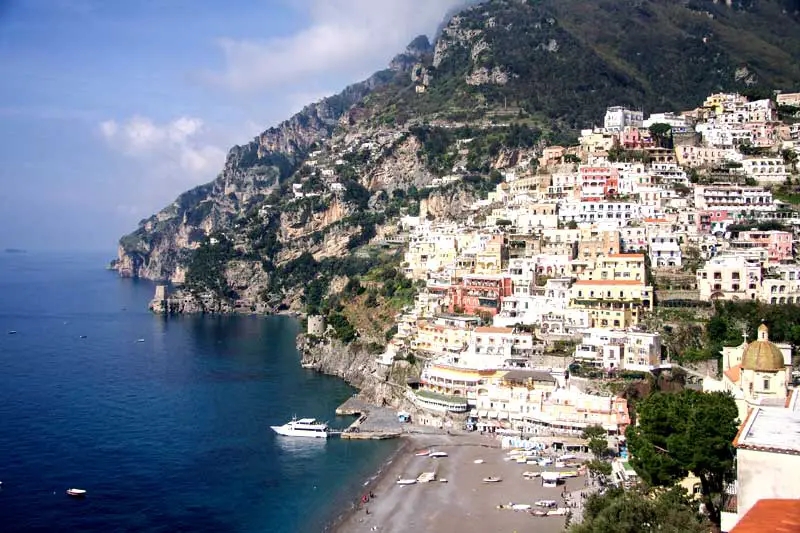
Positano
Positano is a small picturesque town with splendid coastal views, on the famous Amalfi Coast in Campania, Italy. The town itself is perched on an enclave on the face of a hill and winds down towards the waters of the Amalfi Coast. Naturally beautiful, Positano attracts thousands of visitors every year. All year long, the town is always full of people, but if you are planning to visit Positano, it would be best to schedule your trip during the spring season. Getting around on foot is easy – there are lots of little stairs leading from everywhere to everywhere. If you are unfit, or just dont like climbing stairs, its worth booking your accomodation close to where you would like to spend your time to save stairclimbing. Alternatively there is the one road meandering down to the harbour. Buy a Positano town tourist map as soon as you can, showing all the stairways and lane ways, as well as roads, beaches etc. A local bus goes down and – especially – up the hill following the meandering always congested road.
Unless you are prepared to take on the local motorists and heavily congested roads, the best way to get to Positano by the Sita bus from Sorrento or Salerno (a bit longer, but nice). From Sorrento sit next to a window on the right hand side for the best views. From Salerno sit on the left side for the best views and excellent photo opportunities. The bus drops you at the top of the town. During the peak season (starting in late April) this bus can get very crowded. You may have to wait a couple hours and fight your way onto a bus to get back.
A popular activity is to soak up the beauty on either of Positano’s two beaches: Fornillo, the smaller, more secluded beach is accessible either by a set of stairs from the grotto above or via a path from Spiaggia Grande. Fornillo has a more laid back atmosphere with four beach bars lining the shore and no ferry traffic. Spiaggia Grande, the main beach and ferry port, is the hub of activity in Positano. Don’t miss it, but don’t forget there is much more to Positano. You can also take a ferry trip to Paestum or Ischia and Capri (including the Blue Grotto) during summer months, or if you are after luxury, charter a private motor-boat with Charter La Dolce Vita – you can design your own itinerary with the captain. Suggested ideas include departing Positano for a full-day tour to Capri, circling island with the grottos or out to Ischia, or along the Sorrento Coast or just cruising along the Amalfi Coast.
More

Amalfi Coast
The town of Amalfi is the heart of this magnificent Italian coastline known as the Amalfi Coast. Amalfi is one of the bigger towns on the Amalfi coast. It has squares connected by pedestrian streets full of restaurants, souvenir shops and tourists.
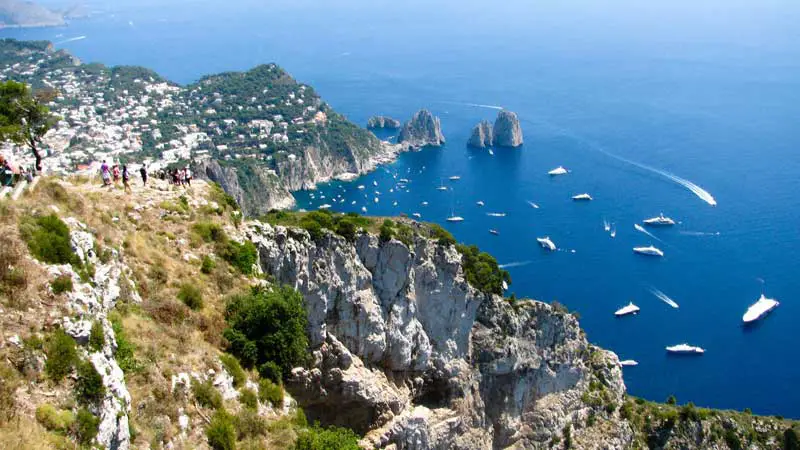
The mountains along the Amalfi Coast have a hidden network of public footpaths and long stairs criss crossing the lemon teraces. From Montepertuso you can walk to Santa Maria, a small church high up, and back down to Positano. This will give you stunning views down the coast featuring Capri, Positano and the sea. In springtime all sorts of rare spices and flowers grow between the cypress trees. Make sure you get a map of some kind showing the footpaths since you WILL get lost without one. For those who are truly adventurous, scooters can be a practical form of transport, however precision driving is key. Remember that The Amalfi Coast roads are very narrow and cliff-hanging, and will provide a challenging drive, but there are many spots to stop along the coastal roads and small towns that are only easily accessible if you have your own wheels.
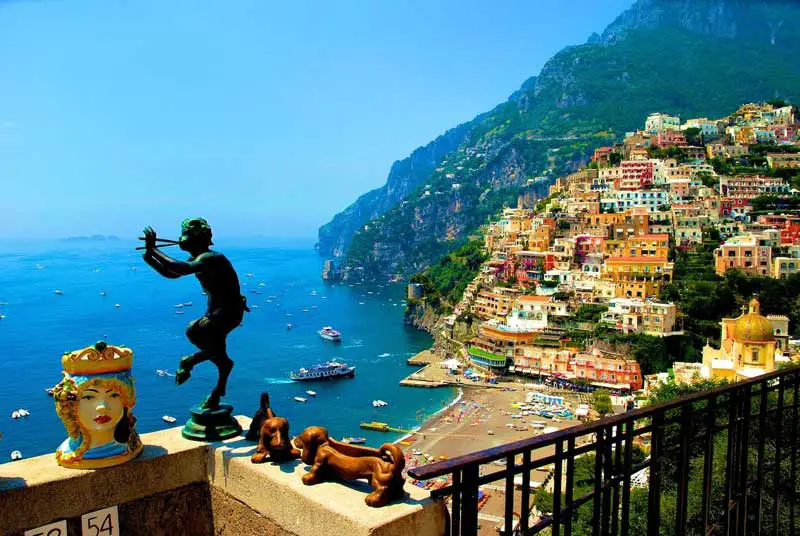
Amalfi is approx. 40 minutes from Positano (depending on traffic). The trip to Amalfi from Sorrento is approx. 1 hour and 15 minutes (depending on traffic) otherwise this can blow out to two hours. July and August are prime months for people-moving so the buses can become very crowded so make sure you are at the front of the pushy crowd when the bus pulls up otherwise you might have to wait for the next one. It is a comfortable way to travel along the Amalfi Coast and Sorrentine Peninsula, however if you are prone to motion sickness the hairpins on these roads will certainly induce symptoms very quickly! SITA offers a very efficient public transportation service in the area, with expert drivers who breeze along the winding roads like they were driving on a highway (you will be happy to know that they are experienced).
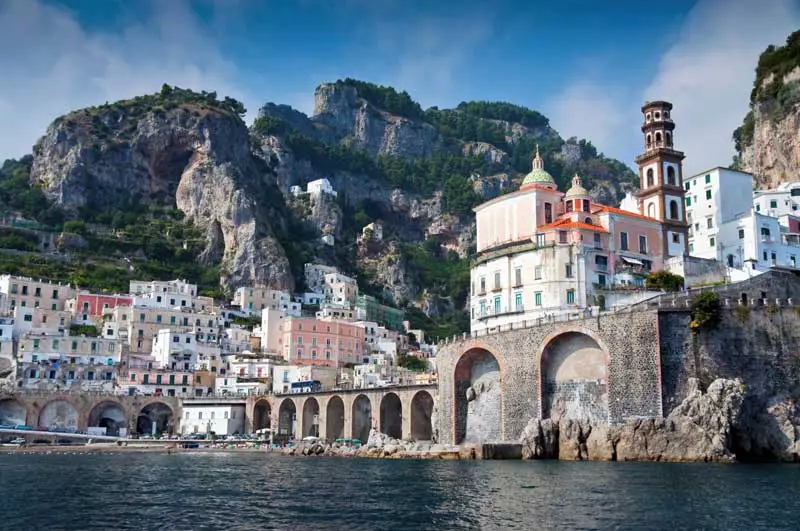
A cruise or ferry ride is a popluar way to see the Amalfi Coast. The ferry season opens from Easter weekend and runs until mid to late October with connections from Amalfi to Positano, Salerno, Capri, Naples and Sorrento. The Metro del Mare is an extension of urban public transport – by sea. It connects the northern ports of Bacoli and Pozzuoli to Naples and from there goes to Sorrento, Positano, and Amalfi. Headquartered in Amalfi, Coop Sant’Andrea ioperates ferries from Salerno to Amalfi, Amalfi to Salerno, Amalfi to Positano, Positano to Amalfi, Positano to Salerno, Salerno to Positano and connections in summer between Amalfi-Minori-Maiori. There are also private boat charters offered at the ticket kiosks on the Molo Pennello pier.
The two main train stations serving the Amalfi Coast are Salerno which has direct Eurostar and inter-regional trains connections to Naples and Rome and the local Circumvesuviana over in Sorrento which is the main train line which connects Sorrento to Naples and importantly, Sorrento to Pompeii ruins. Conveniently, both stations are also hubs for cheap, efficient bus and ferry services radiating toward the major tourist destinations along the Amalfi Coast and inland.
We recommend the Capri Boat Excursion, a full-day sightseeing tour taking in all the Amalfi Coast villages, including Ravello, Positano, Atrani, Praiano, Maiori and Minori. You visit the grottos in Capri and Amalfi, you can go swimming directly from the boat, the tour circumnavigates Capri island and you have the opportunity to disembark in Capri for three hours of your own time before you cruise back at about 6pm. Departures from Amalfi, Maiori and Minori.
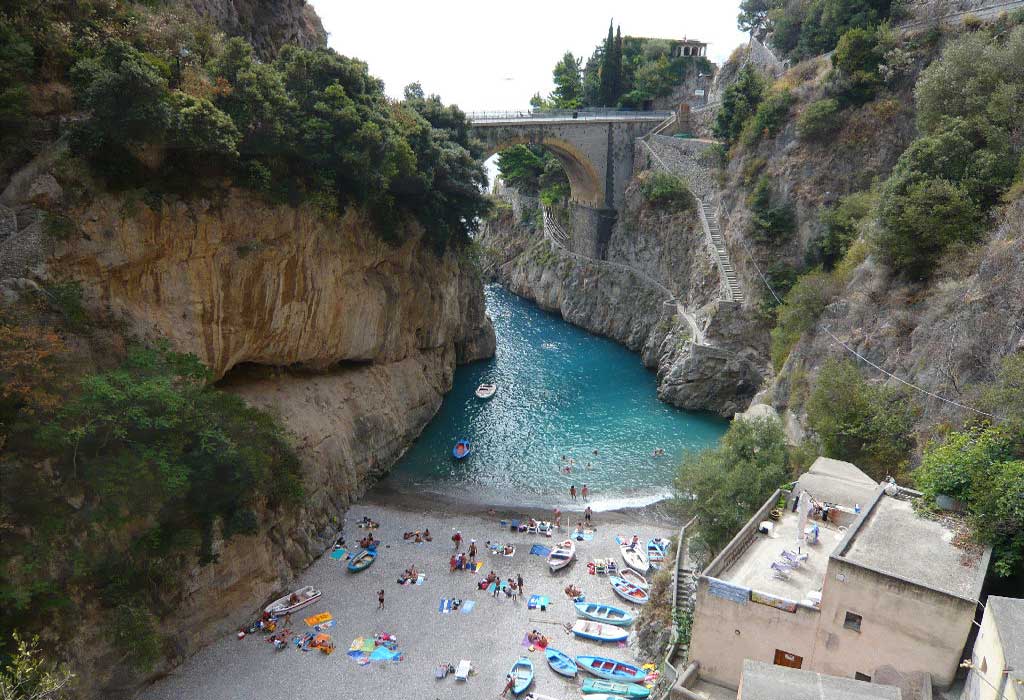
Furore
The Amalfi Coast town of Furore hosts the famous Fjord of Furore, a secret cove with fisherman’s houses. Furore is about 25 minutes from Amalfi by SITA bus or car via the main Amalfi to Positano coastal road. Furore is the ideal location for trekking along the slopes of the Lattari Mountains, and not far from the Highway of the Lattari Mountains : “The Path of the Gods.” Other interesting and spectacular paths especially for the views, Sentiero della Volpe Pescatrice (The Fishing Vixen Path) from Punta Sant’Elia to the Fiord of Furore, and the path of the Agave in Fiore (The Agave in Flower), along this path leading from Punta Sant’Elia to Praiano, you will be able to find many agave, that after producing the incredible flower will die.
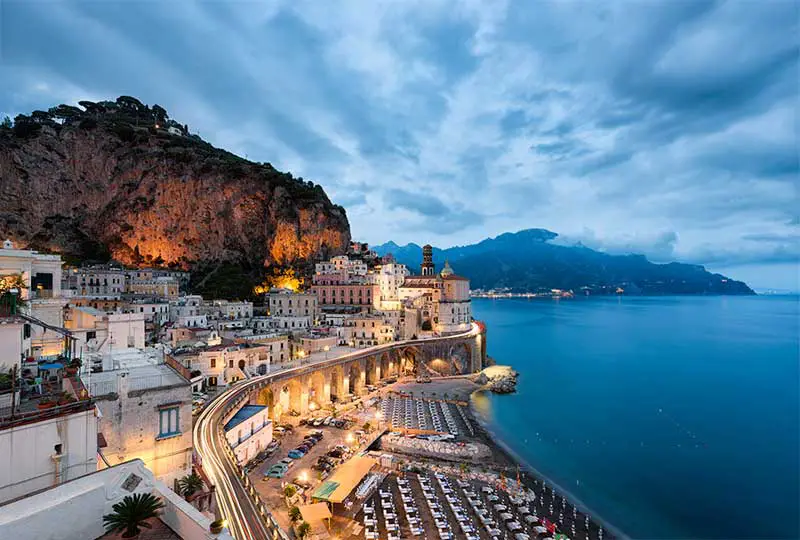
Atrani
Atrani is on the Amalfi Coast, just 700 meters away from the more famous Amalfi. Atrani maintains its distinct fishing town atmosphere. The main entrance to the town starts from the beach, and from there, the traditional houses climb up the steep mountain valley, intertwined with gardens and lemon terraces. Atrani has little traffic and noise, even in summer, because it only opens to the beach and the sea. This is probably the secret of its pleasant square, where a few bars and restaurants have opened.
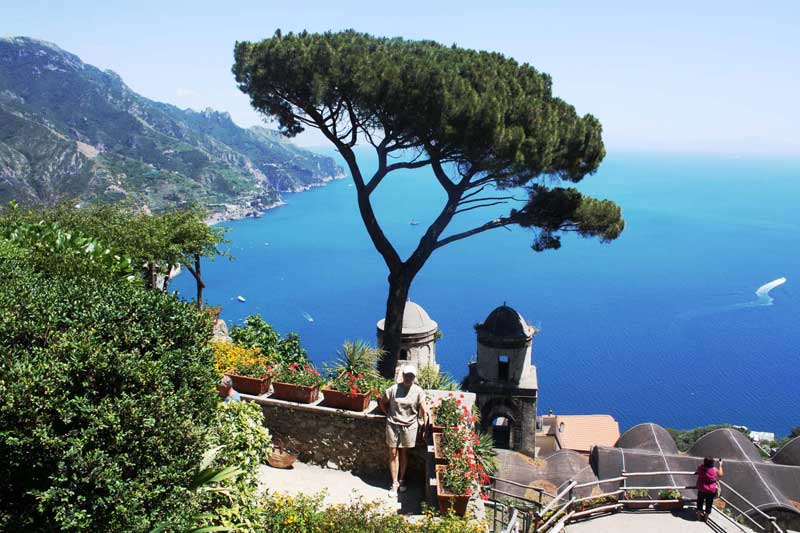
Ravello
Ravello is located in the hills above Amalfi. A peaceful area with a small population, Ravello offers stunning views of the Mediterranean. Visit their renowned gardens, Villa Cimbrone and Villa Rufolo, and their spectacular Duomo, the Cathedral of Ravello, which is located in Vescovado Square. During summer months the city hosts the annual Ravello Festival, an event started in 1953 in honor of Richard Wagner and continued as a celebration of local art and music. You can reach Ravello by taking the prevalent SITA buses that run throughout the Amalfi Coast between the cities of Salerno, Positano, Sorrento. You will disembark at the city of Amalfi and from there you can either take a different SITA bus up the hill or walk to Ravello.
More
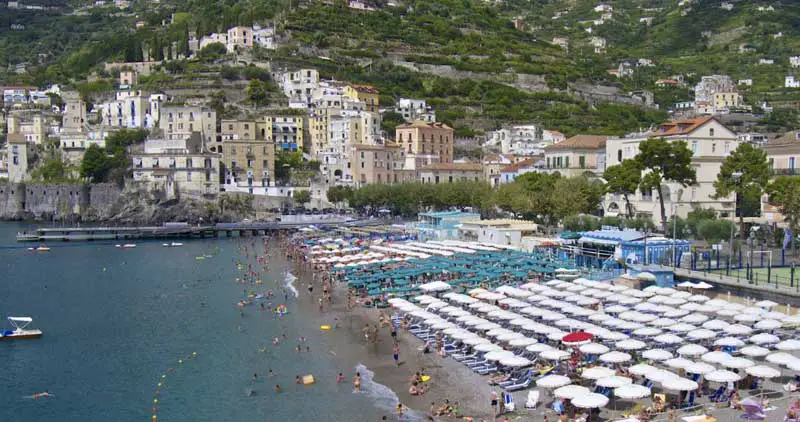
Maiori
Maiori is the only real beach along the Amalfi Coast. Most of the beach is privatized, making it effectively impossible to go to the beach without paying a fee. Even when there, the beach is covered in rows of beach umbrellas and deck chairs, something Australian beachgoers will find both strange and calaustophobic if you intend to spend some time there. The local SITA bus company run buses all over the Amalfi Coast with excellent connections to Amalfi, Ravello, Positano, Salerno and Sorrento.

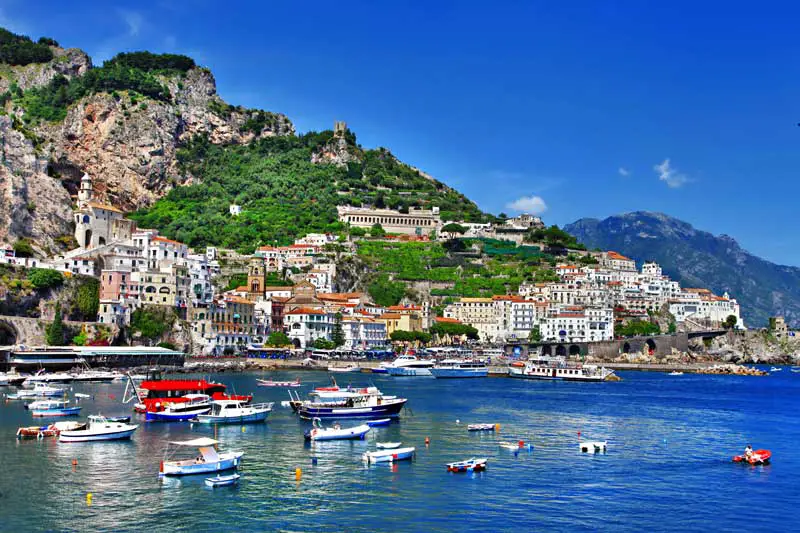
Salerno
Salerno is the principal town of the province with the same name, and today numbers around 145,000 inhabitants. For a brief period (February to August 1944) Salerno was the capital city of Italy, during the liberation after the allied landings before the fall of Monte Cassino to the allies and the subsequent liberation of Rome. Today it is a lively port town, that is rapidly re-acquiring a relaxing and open Mediterranean atmosphere. The port area itself is not particularly attractive, but once you get onto the promenade things get better. Worth a visit also is the Historical Old Town, which has in recent years recovered from being a virtual no-go area to being one of the best preserved historical town centers, full of tiny little passageways and hidden corners.
Salerno is an ideal stopping off point on the way to Paestum, Pompeii or Positano, or the Cilento and Vallo di Diano National Park, which is a lesser known UNESCO World Heritage site. Placed as it is at one end of the Amalfi Coastline, it is an important passing point for the local tourism scene. Also worth a visit if you happen to be in the area are Vietri sul Mare, for the traditional ceramics, Cava de’ Tirreni for the important Abbey at La Badia and one of the few remaining Portici in Campania.
More
